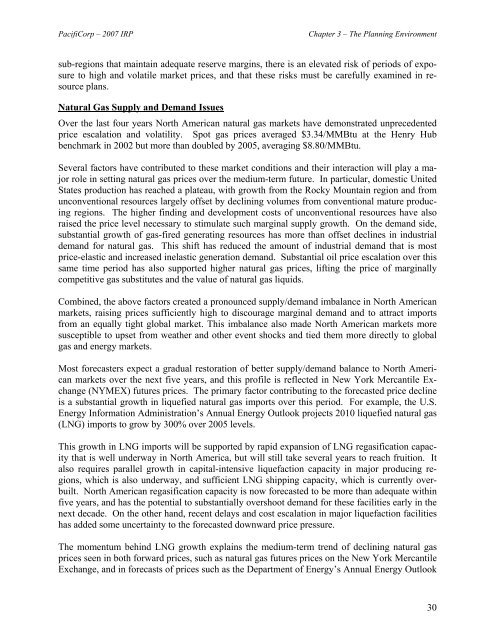PacifiCorp 2007 Integrated Resource Plan (May 30, 2007)
PacifiCorp 2007 Integrated Resource Plan (May 30, 2007)
PacifiCorp 2007 Integrated Resource Plan (May 30, 2007)
You also want an ePaper? Increase the reach of your titles
YUMPU automatically turns print PDFs into web optimized ePapers that Google loves.
<strong>PacifiCorp</strong> – <strong>2007</strong> IRPChapter 3 – The <strong>Plan</strong>ning Environmentsub-regions that maintain adequate reserve margins, there is an elevated risk of periods of exposureto high and volatile market prices, and that these risks must be carefully examined in resourceplans.Natural Gas Supply and Demand IssuesOver the last four years North American natural gas markets have demonstrated unprecedentedprice escalation and volatility. Spot gas prices averaged $3.34/MMBtu at the Henry Hubbenchmark in 2002 but more than doubled by 2005, averaging $8.80/MMBtu.Several factors have contributed to these market conditions and their interaction will play a majorrole in setting natural gas prices over the medium-term future. In particular, domestic UnitedStates production has reached a plateau, with growth from the Rocky Mountain region and fromunconventional resources largely offset by declining volumes from conventional mature producingregions. The higher finding and development costs of unconventional resources have alsoraised the price level necessary to stimulate such marginal supply growth. On the demand side,substantial growth of gas-fired generating resources has more than offset declines in industrialdemand for natural gas. This shift has reduced the amount of industrial demand that is mostprice-elastic and increased inelastic generation demand. Substantial oil price escalation over thissame time period has also supported higher natural gas prices, lifting the price of marginallycompetitive gas substitutes and the value of natural gas liquids.Combined, the above factors created a pronounced supply/demand imbalance in North Americanmarkets, raising prices sufficiently high to discourage marginal demand and to attract importsfrom an equally tight global market. This imbalance also made North American markets moresusceptible to upset from weather and other event shocks and tied them more directly to globalgas and energy markets.Most forecasters expect a gradual restoration of better supply/demand balance to North Americanmarkets over the next five years, and this profile is reflected in New York Mercantile Exchange(NYMEX) futures prices. The primary factor contributing to the forecasted price declineis a substantial growth in liquefied natural gas imports over this period. For example, the U.S.Energy Information Administration’s Annual Energy Outlook projects 2010 liquefied natural gas(LNG) imports to grow by <strong>30</strong>0% over 2005 levels.This growth in LNG imports will be supported by rapid expansion of LNG regasification capacitythat is well underway in North America, but will still take several years to reach fruition. Italso requires parallel growth in capital-intensive liquefaction capacity in major producing regions,which is also underway, and sufficient LNG shipping capacity, which is currently overbuilt.North American regasification capacity is now forecasted to be more than adequate withinfive years, and has the potential to substantially overshoot demand for these facilities early in thenext decade. On the other hand, recent delays and cost escalation in major liquefaction facilitieshas added some uncertainty to the forecasted downward price pressure.The momentum behind LNG growth explains the medium-term trend of declining natural gasprices seen in both forward prices, such as natural gas futures prices on the New York MercantileExchange, and in forecasts of prices such as the Department of Energy’s Annual Energy Outlook<strong>30</strong>
















